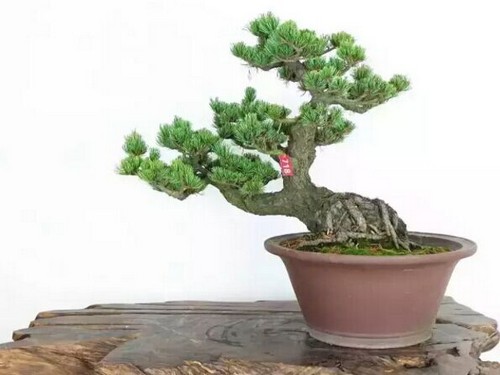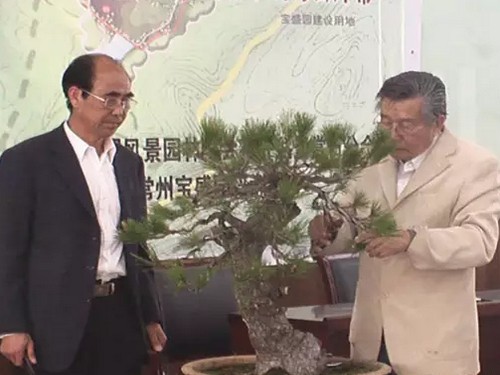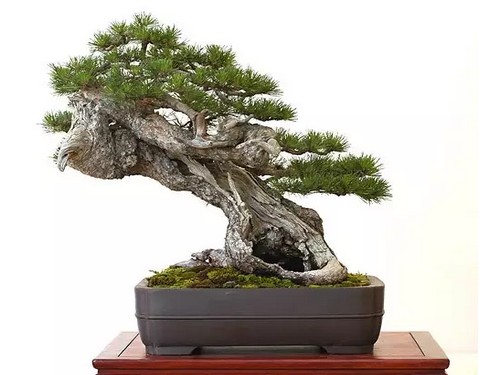Fertilization method of Pine Bonsai
In the wild, most pine trees grow in poor ridges or high altitude areas, and are pioneer species of positive (good sunlight), which means that pine trees can grow well without using too much fertilizer. Horticulture in order to enable the tree to grow quickly and shorten the cultivation time, we amateur players, especially us amateur players, do not hesitate to fertilize and wish the tree could grow an inch in a night.

Because bonsai is cultivated in limited pot space and planting soil, organic matter is broken down into inorganic salts by bacteria and absorbed by tree roots. With the growth and consumption of pine trees, the necessary nutrients in the basin are gradually reduced, resulting in insufficient nutrition and difficult to grow, so nutrients must be replenished regularly. Fertilization must grasp the quality and quantity of fertilizer used in pine growth and storage period in order to give full play to the effect of fertilizer and meet the growth needs of pine trees.
Fertilization should vary according to different tree species, tree age, basin size and fertilizer quality. Fertilization must be based on root growth, distribution, absorption and other characteristics to determine what kind of fertilizer to apply. Generally speaking, more fertilizer should be applied during the growing period and nutrient accumulation period, and less fertilizer should be applied to finished trees and dormant trees.
Basic principles of fertilization:
The organic fertilizer applied must be fully mature, and the raw fertilizer that has not been fermented can not be used. Unfermented raw fertilizer can damage the roots of pine trees and affect the surrounding environment. No matter using organic fertilizer or inorganic fertilizer, you should apply less diligently. Fertilization must be timely, if the leaf color becomes lighter and the growth is weak, nitrogen fertilizer should be applied immediately. Fertilization should take into account the temperature when the temperature exceeds 25. C should not be fertilized.
Fertilizer can be divided into natural organic fertilizer and chemical synthetic inorganic fertilizer. The concentration of inorganic fertilizer is high and its composition is stable. if inorganic fertilizer is used for a long time, it is easy to acidify or alkalize the basin soil and hinder the growth of pine trees. The organic fertilizer used should be fully fermented before use. After diluting the original juice with 10 times of water, pour it into the basin soil. People who are afraid of odor can add sulfite and then pour it. In addition to the effect of deodorization, leaves can increase green and reduce melanin.
1. Fertilization in spring:
If the tree is weak, it can be fertilized earlier, and the time is about 2 ~ 3 months after budding. Since the tree is weak, it cannot and does not need to apply too much fertilizer at one time. Every year, the bonsai of pine trees is turned from February to March, and fertilization begins in May, once every 15 days, three times in a row, because this is the growing period of pine trees. To mid-June to stop fertilization, because the temperature is higher, fertilization is easy to hurt the root. Pine bonsai should apply more phosphorus and potassium fertilizer and less nitrogen fertilizer.
2. Fertilization in autumn:
In late summer and early autumn, about August to September, the weather began to cool, and the pine trees began to grow rapidly after summer dormancy. Generally speaking, autumn fertilizer must be under, autumn fertilizer absorption is not enough, the next spring bud growth will not be good, affecting the growth of the whole year.
If the temperature in summer is too high and the sun is strong, the temperature in winter is low and the sun is weak, and the growth of pine trees slows down (the cells that grow in summer are as big as those in spring and autumn, or even larger, and you can't see the slow growth in summer from the growth rings). There is no need for (too much) fertilizer, especially under the full sunshine in summer, water evaporates rapidly, and if too much fertilizer remains in the basin soil, it may be because of water evaporation. The concentration of ions (fertilizer) in the water increases sharply, causing fertilizer injury, even if it does not reach the degree of fertilizer injury, it will reduce the ability of plants to absorb water because of osmotic pressure, and reduce the cooling effect of pine trees especially by evapotranspiration when the temperature is high.
After changing the basin, it is best to apply fertilizer at an interval of 1 to 2 months. If you miss the opportunity, it doesn't matter if you don't apply fertilizer next time (only pulling out the pot without removing the soil, you can apply fertilizer in accordance with the timing of fertilization in the Spring and Autumn period a week later, but it should not affect the extension of the new root excessively).
Fertilization begins at the beginning of October every year, once every 15 days, twice in succession, and more phosphorus and potassium fertilizer is applied to facilitate the accumulation of nutrients. Attention should be paid to:
(1) the basin noodles should not be too dry, because too dry fertilization is easy to hurt the roots, and do not be too wet, too wet fertilization roots can not be absorbed, easy to rot roots.
(2) fertilization should be applied less frequently, and it is most suitable for pot soil not to be dry or wet. Nitrogen fertilizer is an important element of protein. If the nitrogen fertilizer is insufficient, the foliar surface will become lighter and the growth will decline: if there is too much nitrogen fertilizer, the stems and leaves will become weak, and the main function of nitrogen fertilizer is foliar fertilizer.
(3) Phosphate fertilizer can form cells and has a great effect on cell division. It plays the most important role in combination with nitrogen and potassium, and the deficiency of phosphorus will cause root dysplasia. Phosphate fertilizer is mainly bone powder, and phosphate fertilizer can promote flowering and fruiting.
(4) Potash fertilizer has a great effect on photosynthesis and can help to transport nutrients to roots and branches and make them stretch and move. Potassium can adjust the over-acidic basin soil, and plant ash can also be used to correct the acidity of the soil. Potash fertilizer can strengthen the roots, promote the absorption of ammonia and phosphorus, and strengthen cold and heat tolerance.
Time: 2019-06-12 Click:
- Prev

Technical guide for modeling of pine bonsai
Every creature in nature is affected by other creatures, and people interfere with the growth of pine trees through technical means, which is a manifestation of this effect. To this day, this phenomenon still exists, which is the prevalence of potted plants. Pine tree is of great significance in Chinese traditional culture, symbolizing the character of perseverance.
- Next

Watering skills of Pine Bonsai
Water is an element of plant growth, accounting for about 70% of the total plant composition, and it is one of the most important conditions for plant growth. So watering is also a very important knowledge. Watering seems simple, but it is not easy to operate it well. A good bonsai technician needs three years of careful research, exploration and summary.
Related
- Fuxing push coffee new agricultural production and marketing class: lack of small-scale processing plants
- Jujube rice field leisure farm deep ploughing Yilan for five years to create a space for organic food and play
- Nongyu Farm-A trial of organic papaya for brave women with advanced technology
- Four points for attention in the prevention and control of diseases and insect pests of edible fungi
- How to add nutrient solution to Edible Fungi
- Is there any good way to control edible fungus mites?
- Open Inoculation Technology of Edible Fungi
- Is there any clever way to use fertilizer for edible fungus in winter?
- What agents are used to kill the pathogens of edible fungi in the mushroom shed?
- Rapid drying of Edible Fungi

